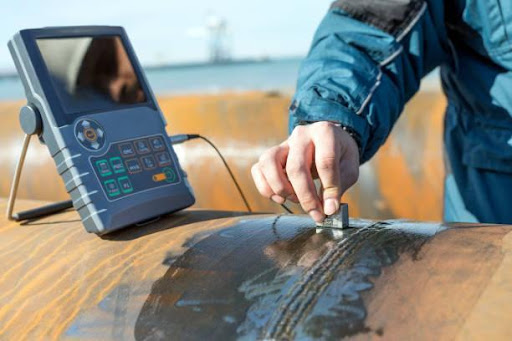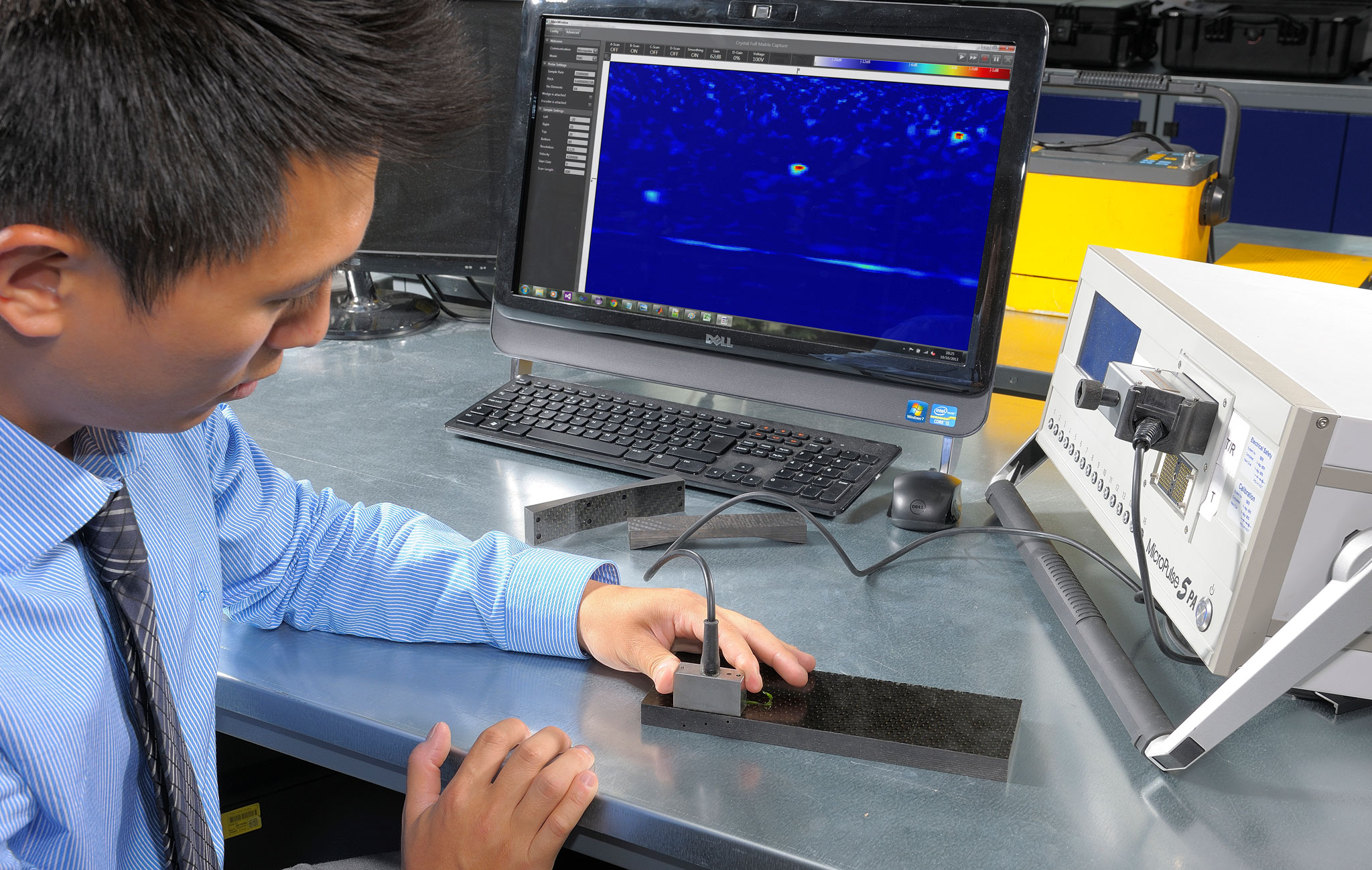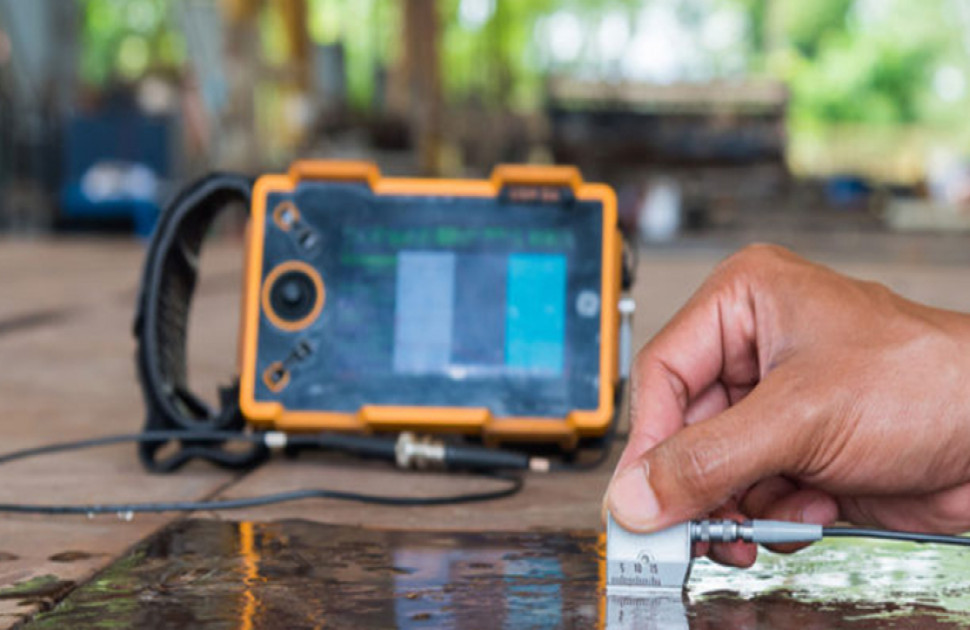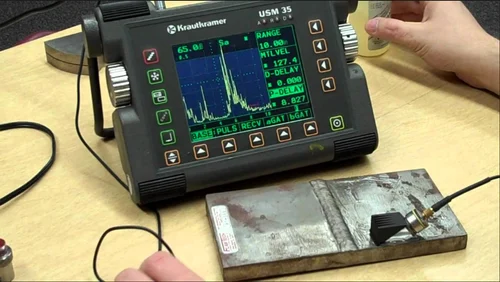Table Of Contents
- Introduction
- What is Ultrasonic Testing?
- Types of Ultrasonic Testing
- Need for Ultrasonic Testing and Its Applications
- Conclusion
- Key Takeaways
Introduction
Ultrasonic Testing (UT) uses high-frequency sound energy to conduct examinations and measurements.
Ultrasonic inspection can be used for flaw detection/evaluation, dimensional measurements, material characterization, and more.
Ultrasonic testing inspection plays a crucial role in the field of Non-destructive Testing (NDT).
Its extensive influence extends to the assessment of material integrity and structural soundness in various engineering applications.
Using high-frequency sound waves, this NDT Method enables engineers to thoroughly examine solid objects, revealing hidden flaws, inconsistencies, or defects without causing harm.
Its significance lies in its precision and versatility, providing insights into the internal structure of materials, the detection of cracks, voids, or thickness variations, and even the measurement of material properties.
In this article, we delve into the world of Ultrasonic Testing (UT), exploring its principles and applications, and the transformative impact it has had on ensuring the safety and reliability of critical components through a variety of NDT techniques.
What is Ultrasonic testing?

Ultrasonic Testing (UT) is a method employed in the domain of Non-destructive Testing (NDT) to evaluate the internal structure of materials with the aid of high-frequency sound waves.
The process unfolds as follows:
1. Equipment Configuration:
- The essential apparatus for Ultrasonic Testing encompasses three primary components: a transducer (also referred to as a probe), a couplant, and a display unit.
- The Ultrasonic Transducer, a handheld device, serves the role of generating and receiving ultrasonic waves.
- To facilitate acoustic coupling, a coupling, often in the form of a gel or oil, is applied to the material's surface.
- The display unit assumes the function of presenting results and rendering a graphical representation of the detected signals.
2. Generation of Ultrasonic Waves:
- Ultrasonic waves, characterized by their elevated frequency, typically ranging from 1 to 10 megahertz (MHz), are generated by the transducer through the utilization of the piezoelectric effect.
- The application of an electric voltage induces vibrations within the Transducer, resulting in the emission of ultrasonic waves.
3. Transmission into the Material:
- The ultrasonic waves are meticulously conveyed into the material under examination.
- When these waves encounter interfaces between dissimilar materials or anomalies within the material, a portion of the waves is reflected toward the Ultrasonic Transducer.
4. Reception of Reflected Waves:
- Acting as a receiver, the transducer captures the reflected ultrasonic waves.
- These received waves are subsequently transduced into electrical signals, which are transmitted to the display unit for analytical processing.
5. Signal Analysis:
- The display unit performs an intricate analysis of the received signals and renders a visual representation, typically in the form of an A-scan or B-scan.
- An A-scan provides a graphical representation of the ultrasonic wave travel time, affording insights into the depth of any detected defects.
- A B-scan furnishes a two-dimensional image of the material under scrutiny, enhancing the ability to identify and localize imperfections.
Proficient technicians undertake a meticulous examination of the acquired data to ascertain the presence and characteristics of defects, such as cracks, voids, or variations in material thickness.
The recorded data is scrutinized to determine the dimensions, morphology, and precise locations of these anomalies.
Ultrasonic Testing serves as a vital technique in diverse industries, encompassing aerospace, manufacturing, construction, and the Oil and Gas Industry, where it plays a pivotal role in quality control and safety assurance by providing a non-destructive and highly sensitive means of assessing material integrity and structural soundness.
Types of Ultrasonic Testing
Ultrasonic Testing (UT) comprises various techniques that are instrumental in the field of ultrasonic Non-destructive Testing (UT NDT).
Each method serves specific ultrasonic inspection needs and offers distinctive advantages.
Some types of Ultrasonic Testing include:
1. Pulse-Echo and Through-Transmission Testing (Ultrasonic Testing NDT):
- Pulse-Echo Testing (Ultrasonic NDT Testing):
Pulse-echo ultrasonic testing utilizes a single transducer for both ultrasonic transmission and reception.
This method emits a pulse of ultrasonic waves into the material, subsequently analyzing echoes to detect flaws or defects.
It is frequently applied in situations where access is constrained, including the inspection of welds and solid surfaces.
- Through-Transmission Testing (Ultrasonic Inspection NDT):
Through-transmission Ultrasonic Testing (UT) involves two transducers: one for transmission and another for reception.
It is ideal for assessing materials of greater thickness and can identify anomalies that pulse-echo techniques might overlook.
This method finds extensive use in aerospace for examining composite materials.
2. Contact and Immersion Testing (Ultrasonic Examination NDT):
- Contact Testing (Ultrasonic NDT Inspection):
Contact Ultrasonic Testing necessitates direct coupling between the transducer and the material's surface.
A couplant, such as gel or oil, ensures efficient acoustic transmission.
This method is practical for inspecting metals, plastics, and other solid surfaces, making it an essential tool in manufacturing for quality control.
- Immersion Testing (Ultrasonic Inspection NDT):
Immersion Ultrasonic Testing (UT) immerses the material in a liquid bath, with the transducer situated within the liquid.
Ultrasonic waves travel from the liquid into the material, facilitating comprehensive assessment.
Immersion testing is invaluable for inspecting complex shapes and large components, and it is frequently applied in the assessment of composite structures in the Aerospace Industry.
3. Angle Beam and Time-of-Flight Diffraction (TOFD) Testing (Ultrasonic NDT Test):
- Angle Beam Testing (Ultrasonic NDT Inspection):
Angle beam ultrasonic testing employs specialized transducers that emit ultrasonic waves at specific angles, facilitating the detection of inclined flaws.
This method is instrumental in the examination of welds for flaws like cracks and lack of fusion.
- Time-of-Flight Diffraction (TOFD) Testing (Ultrasonic NDT Examination):
TOFD is an advanced technique that measures the time it takes for ultrasonic waves to diffract around defects.
It offers precise sizing and localization of flaws, and it is particularly advantageous in assessing pipeline welds for corrosion and cracks in the oil and gas industry.
4. Phased Array Testing (Ultrasonic NDT Inspection):
Phased Array Ultrasonic Testing employs a set of transducer elements that can be electronically controlled to adjust the angle and focal depth of the ultrasonic beam.
This dynamic control enables efficient scanning of complex geometries, making it indispensable in aeronautics for inspecting turbine blades and other intricate components.
Each type of ultrasonic testing method, whether it's pulse-echo, through transmission, contact, immersion, angle beam, TOFD, or phased array testing, offers distinct capabilities.
The choice of method depends on specific ultrasonic inspection requirements and the nature of the material under evaluation.
These methods collectively contribute to the comprehensive toolkit of ultrasonic Non-destructive Testing (NDT), ensuring the reliability and safety of critical components across diverse industries.
Need for Ultrasonic Testing and Its Applications

Ultrasonic Testing, often referred to as ultrasonic examination or ultrasonic NDT Testing, is an indispensable tool in the field of non-destructive testing (NDT), primarily owing to its ability to reveal hidden structural deformities and ensure the integrity of critical components in various industries.
Its significance arises from its versatility and precision, making it a preferred choice for NDT applications. Ultrasonic testing, part of NDT ultrasonic testing, plays a vital role in identifying a wide range of deformities, including:
- Crack Detection:
It is crucial for detecting cracks, whether in metal welds, aircraft components, or other critical structures.
- Voids and Inclusions:
Ultrasonic testing can identify voids, gas pockets, and inclusions within materials, which could compromise structural integrity.
- Thickness Variations:
This method is valuable for assessing thickness variations in materials, such as corrosion in pipelines or Pressure Vessels.
- Weld Discontinuities:
Ultrasonic testing is a go-to technique for evaluating the quality of welds in construction, ensuring they meet safety standards.
- Material Characterization:
It can be used to determine material properties, including density, hardness, and elastic moduli.
- Composite Inspection:
In industries like aerospace, Ultrasonic Testing (UT) inspection ensures the integrity of composite materials, revealing hidden flaws.
This methodology finds extensive use in industries such as aerospace, manufacturing, construction, and oil and gas, where the safety and reliability of components are of paramount importance.
Ultrasonic testing is the cornerstone of NDT, contributing to the prevention of catastrophic failures and the enhancement of overall structural reliability.
Conclusion
Ultrasonic testing stands as a linchpin in the realm of Non-destructive Testing (NDT), offering invaluable insights into the integrity of critical components across a spectrum of industries.
Its multifaceted applications, encompassing the detection of cracks, voids, thickness variations, and weld discontinuities, underscore its significance in ensuring the reliability and safety of diverse structures and materials.
The working and process of ultrasonic testing, with its precision and versatility, are pivotal in uncovering concealed defects without causing harm, thus minimizing the risk of catastrophic failures.
Ultrasonic examination, an integral component of NDT ultrasonic testing, allows for the precise characterization of materials, a vital factor in quality control.
As we navigate the complexities of modern engineering and manufacturing, the role of ultrasonic testing in the assessment of material properties and structural soundness remains paramount, underscoring the importance of this method as a cornerstone of NDT techniques.
Its ability to meticulously evaluate and ensure the structural integrity of critical components contributes to enhanced safety and reliability across industries, making ultrasonic testing an indomitable force in the world of non-destructive testing.
Key Takeaways
- Ultrasonic testing, a cornerstone of non-destructive testing (NDT), is vital for assessing the integrity of critical components in various industries.
- Its precision, versatility, and ability to detect a wide range of deformities, including cracks and voids, make it essential for preventing catastrophic failures and enhancing structural reliability.
References:
1. Aqgndt










